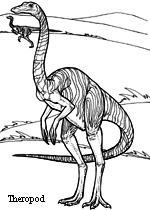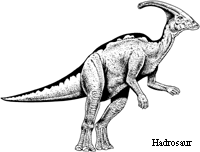 | 
Dinosaur eggs (Sidebar 1)

Dinosaur eggs, representing several different types of dinosaurs, have been found in many locations around the world. Most have been found in Cretaceous rocks in Central Asia (for example, China and Mongolia). Some have also been in Cretaceous rocks in southern Europe, India, and South America. In North America, eggs have been found in both Jurassic and Cretaceous rocks.
Description and Identification of eggs:
Dinosaur eggs have been found in a variety of shapes and sizes. Some are round, while others are oblong. The eggshells consist of calcium carbonate shell units that have pores in them for gas exchange. Paleontologists classify dinosaur eggs by their shape and by the "ultra-microstructure of (the) basic shell unit" (Currie and Padian, 1997). By examining the shell microscopically, structural differences can be found. According to Currie and Padian (1997), the structure of the eggshell is different for major egg-laying groups (birds, dinosaurs, turtles, and crocodiles). Eggs can be classified by their structure, however, the only certain method of identifying a fossil egg is by finding an embryo associated with it. Although finding a fossilized embryo is rare, several types of dinosaur embryos have been found recently.  Examining fossilized embryos and dinosaur nests has allowed us to draw some conclusions about dinosaur habits. For example, since 1979 hundreds of dinosaur eggs have been found in Montana on a mountain called "Egg Mountain." At a nearby site, called Egg Island, eggs were found that are similar in size and morphology to the eggs on Egg Mountain. In addition to the eggs on Egg Island, embryonic remains were found that have been identified as Troodons (a small, meat eating, bipedal theropod dinosaur). The eggs on Egg Mountain were found in nests on the ground with many nests close together. The partial remains of an adult Troodon were found in contact with one nest in a way that looks like the adult was incubating the nest. Thus, from the nests and the embryos, paleontologists speculate that Troodon dinosaurs nested in colonies and incubated their eggs using both body heat and soil (Currie and Padian, 1997; Varracchio, et al., 1997). Examining fossilized embryos and dinosaur nests has allowed us to draw some conclusions about dinosaur habits. For example, since 1979 hundreds of dinosaur eggs have been found in Montana on a mountain called "Egg Mountain." At a nearby site, called Egg Island, eggs were found that are similar in size and morphology to the eggs on Egg Mountain. In addition to the eggs on Egg Island, embryonic remains were found that have been identified as Troodons (a small, meat eating, bipedal theropod dinosaur). The eggs on Egg Mountain were found in nests on the ground with many nests close together. The partial remains of an adult Troodon were found in contact with one nest in a way that looks like the adult was incubating the nest. Thus, from the nests and the embryos, paleontologists speculate that Troodon dinosaurs nested in colonies and incubated their eggs using both body heat and soil (Currie and Padian, 1997; Varracchio, et al., 1997).
 While the embryos of theropods like Troodon developed rapidly and seem to have left the nest as hatchlings, other dinosaurs, including some, if not all, Hadrosaurs (duck-billed) stayed in the nest for some time after hatching. Paleontologists have said this because, while the bones of the Troodon embryos were fully ossified, the bones of some Hadrosaur embryos were not fully ossified and the joints were not fully formed, even though they were going to hatch sooner than the Troodon embryos (Horner and Weishampel, 1988). Also young hadrosaurs have been found resting in nests but young Troodon are not usually found in the nests. Also, the Troodon nests still have the bottom halves of eggshells in them, but these would have been broken if the hatchlings stayed in the nests. Another interesting observation is that some dinosaur embryos apparently ground their teeth in the egg, because their teeth have worn places (Monastersky, 1988). While the embryos of theropods like Troodon developed rapidly and seem to have left the nest as hatchlings, other dinosaurs, including some, if not all, Hadrosaurs (duck-billed) stayed in the nest for some time after hatching. Paleontologists have said this because, while the bones of the Troodon embryos were fully ossified, the bones of some Hadrosaur embryos were not fully ossified and the joints were not fully formed, even though they were going to hatch sooner than the Troodon embryos (Horner and Weishampel, 1988). Also young hadrosaurs have been found resting in nests but young Troodon are not usually found in the nests. Also, the Troodon nests still have the bottom halves of eggshells in them, but these would have been broken if the hatchlings stayed in the nests. Another interesting observation is that some dinosaur embryos apparently ground their teeth in the egg, because their teeth have worn places (Monastersky, 1988).
When some of the dinosaur embryos were found, they revealed several misconceptions that paleontologists had had about certain dinosaurs. For example, the first dinosaur eggs found (in the Gobi Desert in 1923) were all thought to be Protoceratops eggs, because most of the bones in the area were from Protoceratops. Another adult dinosaur was found with a nest, and since he was thought to be raiding the nest, he was called Oviraptor ("egg-stealer"). However, eggs—identical in size, shape and structure to the 1923 eggs—were found in 1993 with Oviraptor embryos in them. Two other adult Oviraptors have been found associated with nests, and it now seems that Oviraptor was not raiding a Protoceratops nests, but was simply protecting or incubating its own nest! (Norell, et al., 1994). Dinosaur Eggs that have been Identified
Many eggs have been identified belonging to the major classifications of dinosaurs (Currie and Padian, 1997). Some of the major groups are listed below. - Most ornithopods (including duck-billed types)
- Ceratopsians (Protoceratops)
- Sauropods (a long-necked type)
- Therizinosaurids ("segnosaur")
- Troodontid (a bipedal meat-eater)
- Oviraptorid (e.g.Oviraptor)
- Perhaps Dromaeosaurid theropods (Velociraptor)
- Perhaps Ankylosaurids
Many statements have been made about dinosaurs' behavior and habits, however without direct observation of a living specimen, it is impossible to have a complete understanding of what dinosaurs did and why they did it. Many types of dinosaurs (if not all) did lay eggs. We can say this because we have found both embryos and hatchlings in nests. Some types of dinosaurs seem to have nested in colonies, and seem even to have incubated their eggs. Some dinosaur hatchlings seem to have left the nest immediately after hatching, while others seem to have stayed in the nests and were fed by their parents. Dinosaur eggs and nests will continue to be interesting and challenging discoveries of the characteristics and possible behavior of the "Terrible Lizards" of the past.
References:
Currie, P.J. and Padian, K. 1997. "Eggs, eggshells and nests" in Encyclopedia of Dinosaurs Academic Press, San Diego. p.205-209.
Horner, J.R. and Weishampel, D.B. 1988. "A Comparative Embryological Study of two Ornithischian Dinosaurs" Nature 332:256-257. Monastersky, R. 1988. "Boom in 'Cute' baby Dinosaur Discoveries" Science News 134(17):261. Norell, M.; Clatk, J.M.; Demberelyin, D.; Rhinchen, B.; Chiappe, L.; Davidson, A.R.; McKenna, M.C.; Altangerel, P.; and Novacek, M. 1994. "A Theropod Dinosaur Embryo and the Affinities of the Flaming Cliffs Dinosaur Eggs" Science 266:779-782. Varricchio, D.; Jackson, F.; Borkowski, J.J.; and Horner, J.R. 1997. "Nest and egg clutches of the dinosaur Troodon formosus and the evolution of avian reproductive traits" Nature 385:247-250. |

